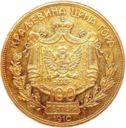- Montenegrin perper
-
Montenegrin perper Црногорски перпер 

20 perper banknote 100 perpera obverse, coin minted in 1910 ISO 4217 code None User(s) Kingdom of Montenegro Subunit 1/100 Para Plural The language(s) of this currency belong(s) to the Slavic languages. There is more than one way to construct plural forms. See article. Coins 1, 2, 10, 20 pare 1, 2, 5, 10, 20, 100 perpera Banknotes 1, 2, 10, 20, 50, 100 perpers This infobox shows the latest status before this currency was rendered obsolete. The perper (Serbian Cyrillic: Перпер; plural перпери) was the currency of Montenegro between 1906 and 1918. The name was adopted in accordance to the earlier Serbian perper, the currency of the Serbian Empire, which the Princedom, later Kingdom of Montenegro, consider itself a successor. It was divided into 100 pare (singular para, Serbian: паре, пара) and was equivalent to the French franc as part of the Latin Monetary Union. The perper was replaced by the dinar when Montenegro became part of the Kingdom of the Serbs, Croats and Slovenes (later Yugoslavia).
At the end of the 20th century, Montenegro contemplated issuing the perper again.[1] However, it decided to adopt the German mark instead, and later followed the change to the euro.
Contents
Coins
In 1906, coins were issued in denominations of 1, 2, 10 and 20 pare. The 1 and 2 pare were bronze, the 10 and 20 pare were nickel. In 1909, silver 1 and 5 perpera coins were added, followed by 2 perpera in 1910. Gold 10 and 20 perpera were also issued in 1910, along with very limited numbers of 100 perpera coins.[2]
Banknotes
Banknotes were issued in 1912 by the treasury in denominations of 1, 2, 5, 10, 50 and 100 perpera. In 1914, the government issued three series on notes, in denominations of 1, 2, 5, 10, 20, 50 and 100 perpera. During the Austrian occupation, government notes of the second and third series were overprinted by the military government district commands. In 1917, the Austrian army issued convertible vouchers denominated in perpera, perpera coins (Münzperper) and Kronen, with 2 perpera = 1 coin perper = 1 Krone.
See also
References
- ^ Central Bank of Montenegro: Jubilarno izdanje perpera
- ^ I. Č.: Stanje u federaciji neodrživo (interview with Slavko Drljevic)
External links
Categories:- History of Montenegro
- Modern obsolete currencies
- Currencies of Europe
- 1906 establishments
- 1918 disestablishments
- Economy of Montenegro
- Currency unit stubs
- Montenegro stubs
Wikimedia Foundation. 2010.
